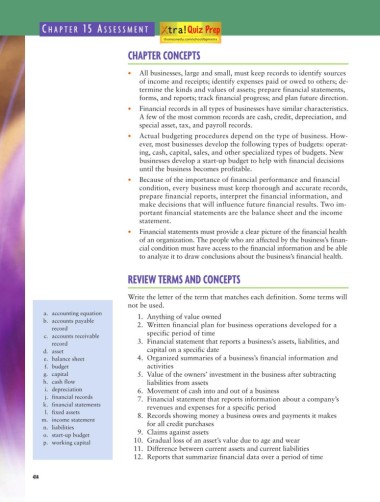Page 427 - Business Principles and Management
P. 427
C HAPTER 15 A SSESSMENT
thomsonedu.com/school/bpmxtra
CHAPTER CONCEPTS
• All businesses, large and small, must keep records to identify sources
of income and receipts; identify expenses paid or owed to others; de-
termine the kinds and values of assets; prepare financial statements,
forms, and reports; track financial progress; and plan future direction.
• Financial records in all types of businesses have similar characteristics.
A few of the most common records are cash, credit, depreciation, and
special asset, tax, and payroll records.
• Actual budgeting procedures depend on the type of business. How-
ever, most businesses develop the following types of budgets: operat-
ing, cash, capital, sales, and other specialized types of budgets. New
businesses develop a start-up budget to help with financial decisions
until the business becomes profitable.
• Because of the importance of financial performance and financial
condition, every business must keep thorough and accurate records,
prepare financial reports, interpret the financial information, and
make decisions that will influence future financial results. Two im-
portant financial statements are the balance sheet and the income
statement.
• Financial statements must provide a clear picture of the financial health
of an organization. The people who are affected by the business’s finan-
cial condition must have access to the financial information and be able
to analyze it to draw conclusions about the business’s financial health.
REVIEW TERMS AND CONCEPTS
Write the letter of the term that matches each definition. Some terms will
not be used.
a. accounting equation 1. Anything of value owned
b. accounts payable 2. Written financial plan for business operations developed for a
record
c. accounts receivable specific period of time
record 3. Financial statement that reports a business’s assets, liabilities, and
d. asset capital on a specific date
e. balance sheet 4. Organized summaries of a business’s financial information and
f. budget activities
g. capital 5. Value of the owners’ investment in the business after subtracting
h. cash flow liabilities from assets
i. depreciation 6. Movement of cash into and out of a business
j. financial records 7. Financial statement that reports information about a company’s
k. financial statements revenues and expenses for a specific period
l. fixed assets 8. Records showing money a business owes and payments it makes
m. income statement for all credit purchases
n. liabilities 9. Claims against assets
o. start-up budget
p. working capital 10. Gradual loss of an asset’s value due to age and wear
11. Difference between current assets and current liabilities
12. Reports that summarize financial data over a period of time
414

